NEWS 2012
Tropical Indo-Pacific Climate Shifts to a More El Nino like State
Honolulu, November 14, 2012
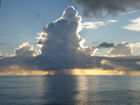 Climate models predict a slowdown of the Walker circulation with global warming. Atmospheric models, however, have failed to reproduce the slowdown already observed over the last 60 years, casting doubt on their ability to simulate slow climate change. Now a study spearheaded by IPRC's Hiroki Tokinaga in this week's issue of Nature has succeeded in simulating the slowdown and shows that changes in the sea surface temperature pattern across the Indo-Pacific are the cause. The image is among the images on the NSF home-page banner, and links indirectly to the story. Read more also in Summit County Citizens Voice; in Science Newsline; in ScienceDaily.
Climate models predict a slowdown of the Walker circulation with global warming. Atmospheric models, however, have failed to reproduce the slowdown already observed over the last 60 years, casting doubt on their ability to simulate slow climate change. Now a study spearheaded by IPRC's Hiroki Tokinaga in this week's issue of Nature has succeeded in simulating the slowdown and shows that changes in the sea surface temperature pattern across the Indo-Pacific are the cause. The image is among the images on the NSF home-page banner, and links indirectly to the story. Read more also in Summit County Citizens Voice; in Science Newsline; in ScienceDaily.
Why Rainfall Projections for the South Pacific Islands Are Still Uncertain
Honolulu, October 28, 2012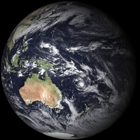 With greenhouse warming, rainfall in the South Pacific islands will depend on two competing effects – an increase due to overall warming and a decrease due to changes in atmospheric water transport – according to a study by an international team of scientists around IPRC’s Matthew Widlansky and Axel Timmermann. In the South Pacific, these two effects sometimes cancel each other out, resulting in highly uncertain rainfall projections. Results of the study are published in the 28 October online issue of Nature Climate Change. Read more: Phys. Org.; Science Daily.
With greenhouse warming, rainfall in the South Pacific islands will depend on two competing effects – an increase due to overall warming and a decrease due to changes in atmospheric water transport – according to a study by an international team of scientists around IPRC’s Matthew Widlansky and Axel Timmermann. In the South Pacific, these two effects sometimes cancel each other out, resulting in highly uncertain rainfall projections. Results of the study are published in the 28 October online issue of Nature Climate Change. Read more: Phys. Org.; Science Daily.
Department of Interior Funds Two IPRC Climate-Change Projects
Honolulu, October 10, 2012
 Today Interior Secretary Ken Salazar announced the funding for projects in the recently established Climate Science Centers. IPRC Director Kevin Hamilton, who is University Director of the Pacific Islands Climate Science Center, is very pleased that two of the funded projects are spearheaded by IPRC scientists: Climate Change Research in Support of Hawaiian Ecosystem Management: An Integrated Approach, led by Oliver Elison Timm, and 21st Century High-Resolution Climate Projections for Guam and American Samoa, led by Yuqing Wang. Read more in Hawaii 24/7, andMaui Now.com.
Today Interior Secretary Ken Salazar announced the funding for projects in the recently established Climate Science Centers. IPRC Director Kevin Hamilton, who is University Director of the Pacific Islands Climate Science Center, is very pleased that two of the funded projects are spearheaded by IPRC scientists: Climate Change Research in Support of Hawaiian Ecosystem Management: An Integrated Approach, led by Oliver Elison Timm, and 21st Century High-Resolution Climate Projections for Guam and American Samoa, led by Yuqing Wang. Read more in Hawaii 24/7, andMaui Now.com.
Earlier Monsoon Onset Impacts Tropical Cyclones in Arabian Sea
September 24, 2012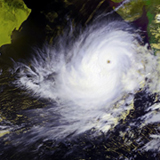
The tropical cyclones in the Arabian Sea during the pre-monsoon season
(May – June) have intensified since 1997 compared to 1979 - 1997. This is the result of decreased vertical wind shear due to a 15-day on average earlier occurrence of tropical cyclones and an earllier monsoon onset, according to a study spearheaded by Bin Wang at the International Pacific Research Center, University of Hawaii at Manoa and published in "Brief Communications Arising" in the September 20, 2012, issue of Nature. Read more in Science Daily; in press release.
NASA’s Martian Weather Reports Reveal Extreme Pressure Swings
September 19, 2012
Curiosity, the NASA rover that landed on Mars last month, is sending us remarkable weather observations from the Martian surface. “The exciting new result from Curiosity is a regular and truly enormous swing in atmospheric pressure through each day. Measurements on Earth show a daily swing in pressure of only about one-tenth of 1% of the mean pressure, whereas Curiosity is measuring swings of almost 10% of the daily average pressure,” says IPRC Director Kevin Hamilton, a pioneer in the area of computer modeling of the Martian atmosphere. “These results confirm a theoretical prediction I made years ago that the daily cycle on Mars could be amplified by a global resonance of the atmosphere.” Read more in Laboratory Equipment; and press release.
Hiroki Tokinaga Awarded Prestigious Prize
 by Meteorological Society of Japan
by Meteorological Society of Japan
July 26, 2012
IPRC Assistant Researcher Hiroki Tokinaga has been awarded the Yamamoto-Shyono Medal by the Meteorological Society of Japan (MSJ) for the work he spearheaded on "Regional Patterns of tropical Indo-Pacific climate change: Evidence of the Walker Circulation weakening," which was published in March 2012 in the Journal of Climate. Each year the society selects two top papers written by young scientists for the award. Tokinaga will receive the medal and give a lecture at the MSJ Autumn Meeting in October, in Sapporo, Japan.
Climate Change and the South Asian Summer Monsoon
Honolulu, June 25, 2012 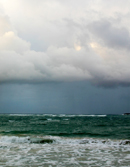
The vagaries of South Asian summer monsoon rainfall impact the lives of more than one billion people. Based on an extensive review of recent research, IPRC’s H. Annamalai and A. G. Turner from the University of Reading in the UK, conclude that with continued rise in CO2 the region can expect generally more rainfall. Regional projections for devastating droughts and floods, however, are still beyond the reach of current climate models. Their review is in the June 24 online edition of Nature Climate Change. Read more in New York Times, ScienceDaily, India's Daily News&Analysis, Uzbekistan News.Net
On the First Anniversary of the Great Tohoku Earthquake

Honolulu, March 9, 2012
On the first anniversary of the Great Tohoku Earthquake, IPRC’s Senior Scientist Nikolai Maximenko speaks about the current status of the tsunami debris that the earthquake generated. Watch on Marine and Tsunami Debris News.
Ocean Conservancy's Japanese Tsunami Debris Webinar
Honolulu, February 28, 2012
 On the upcoming anniversary of the Japanese earthquake and tsunami, the Ocean Conservancy hosted a webinar with IPRC’s Nikolai Maximenko and Ruth Yender, National Oceanic and Atmospheric Administration's Japan Tsunami Marine Debris Coordinator. They shared the latest findings on the tsunami debris. Following the webinar, Maximenko and Jan Hafner held a press conference in which Maximenko updated the press on the findings presented in the webinar. More in KHNO2, KITV, HawaiiNewsNow, Star-Advertiser. Listen to webinar.
On the upcoming anniversary of the Japanese earthquake and tsunami, the Ocean Conservancy hosted a webinar with IPRC’s Nikolai Maximenko and Ruth Yender, National Oceanic and Atmospheric Administration's Japan Tsunami Marine Debris Coordinator. They shared the latest findings on the tsunami debris. Following the webinar, Maximenko and Jan Hafner held a press conference in which Maximenko updated the press on the findings presented in the webinar. More in KHNO2, KITV, HawaiiNewsNow, Star-Advertiser. Listen to webinar.
BBC Features the Tsunami-Debris-Modeling Work by IPRC’s Maximenko and Hafner

Honolulu, February 22, 2012
At this week’s Ocean Sciences Meeting in Salt Lake City, Nikolai Maximenko and Jan Hafner gave an update of their modeling results on the tsunami debris field. The work and the animation of their model showing how the Japanese tsunami debris field has spread since March 2011 is featured on BBC News. Read more.
The Taskforce for Nowcast and Forecast of the 3.11 Tsunami Debris Location Meets at the IPRC
Honolulu, February 21, 2012
 Japanese scientists and governmental representatives met with IPRC’s Tsunami Project Team on February 9 to exchange the latest information about efforts in locating the now widely dispersed tsunami debris. The mission of the task force is to identify the locations of the drifting matter washed into the ocean during the March 11 tsunami by using cutting-edge data assimilation techniques together with the best available ocean, atmosphere, and climate models, and to confirm these locations with satellite imagery and with observational reports. The task force, working under the umbrella of Japanese governmental organizations, is looking into cooperating with other governments on this project, in particular, with the United States. Read more.
Japanese scientists and governmental representatives met with IPRC’s Tsunami Project Team on February 9 to exchange the latest information about efforts in locating the now widely dispersed tsunami debris. The mission of the task force is to identify the locations of the drifting matter washed into the ocean during the March 11 tsunami by using cutting-edge data assimilation techniques together with the best available ocean, atmosphere, and climate models, and to confirm these locations with satellite imagery and with observational reports. The task force, working under the umbrella of Japanese governmental organizations, is looking into cooperating with other governments on this project, in particular, with the United States. Read more.
Swampy Tales Give Clues About Hawaii's Climate Past
Honolulu, February 6, 2012
Until about 14,500 years ago, Hawaii was much cooler than today, with a glacial ice cap of more than 27 square miles sitting on top of Mauna Kea, and very likely an ice cap also on Mauna Loa. What happened to Hawaii’s climate when Earth warmed and the ice sheets in the Northern Hemisphere started to retreat?
IPRC's Axel Timmermann and his geography department colleague David Beilman bushwhack into an ancient crater to find out. Read more.
Tsunami Debris Survey Launched Northwest of Midway
Honolulu, January 25, 2012 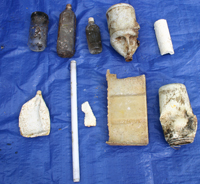
The March 11, 2011, earthquake northeast of Japan and the impact of the subsequent tsunami wave on the Tohoku coastline produced millions of tons of debris. A large amount of the debris was released into the ocean. Under the influence of winds and currents, floating debris is dispersing over a large area and drifting eastward; it is predicted to reach Hawaii and the West Coast of the United States within the coming two years. In order to obtain some certainty about the model predictions, an expedition was made to survey the ocean northwest of Midway during December. Read more about the survey.
Unprecedented, Man-made Trends in Ocean’s Acidity
Honolulu, January 22, 2012
Recent carbon dioxide emissions have pushed the level of seawater acidity far above the range of the natural variability that existed for thousands of years and are affecting the calcification rates of shell-forming organism, according to a study of an international team of scientists led by IPRC's Tobias Friedrich and Axel Timmermann. Their study appears in the January 22 online issue of Nature Climate Change. Read more in USA Today; in Environmental News Network; in Star-Advertiser;
For animation click here.
Tsunami Debris Exploration Uncovers New Theories, More Questions
January 18, 2012
Nikolai Maximenko was interviewed by KITV 4 regarding findings by residents on Molokai, who thought they had spotted tsunami debris. Maximenko took this opportunity to review the various sightings of actual debris from the tsunami and to describe the recent expedition in search of such debris northwest of Midway. Listen and read more.
Pusan National University and IPRC Partner on Monsoon Studies
January 11, 2012
 Atmospheric scientists at Pusan National University (PNU) and climate modelers at the International Pacific Research Center are joining forces to study one of the most challenging issues facing today’s scientists – predicting climate change, especially the changes that may take place with the East Asian and Global Monsoon under global warming. To launch the project between PNU's Global Research Monsoon Laboratory and the IPRC, a two-day workshop was held at the IPRC on January 9 and 10. Read more.
Atmospheric scientists at Pusan National University (PNU) and climate modelers at the International Pacific Research Center are joining forces to study one of the most challenging issues facing today’s scientists – predicting climate change, especially the changes that may take place with the East Asian and Global Monsoon under global warming. To launch the project between PNU's Global Research Monsoon Laboratory and the IPRC, a two-day workshop was held at the IPRC on January 9 and 10. Read more.
News Archive: 2011, 2010, 2009, 2008, 2007, 2006, 2004, 2003, 2002, 2001, 2000

